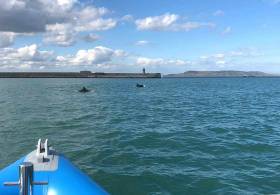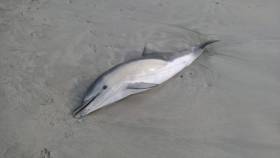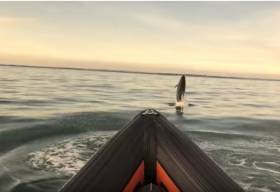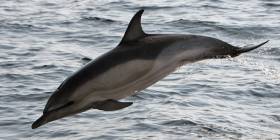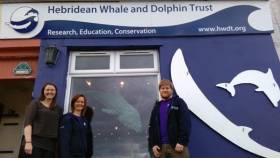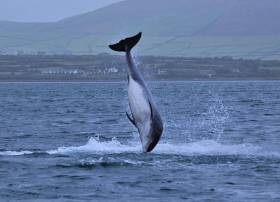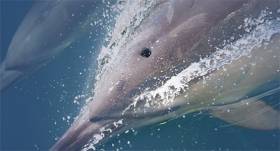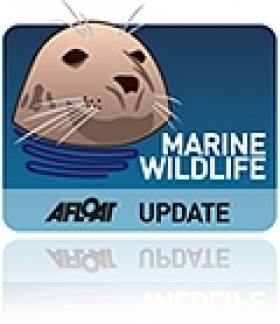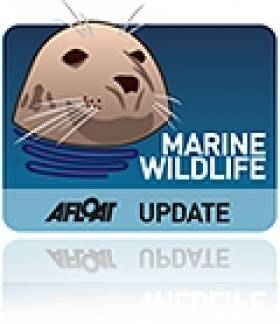Displaying items by tag: Dolphin
The National Yacht Club's Mal Nowlan couldn't believe his eyes on Saturday afternoon when a pod of dolphins came into the harbour to play around his boat.
'I was calibrating my RIB’s compass when DBSC’s Committee Boat 'Freebird' came into the harbour after racing. I thought my eyes were codding me as I glimpsed something rise off her bow', Mal told Afloat.ie.
Dolphins have become relatively common in the Bay in recent years but they're still a very rare sight within the harbour walls.
'I watched and saw what I reckon was a group of five dolphins escort Freebird almost to the marina break-water before turning and heading slowly back to sea', Mal said.
Reports from Scotland say, from April into May, dolphins are widely expected as the migratory salmon run picks up a bit of pace and the dolphins arrange themselves around specific places. Perhaps this is a coming trend further down the Irish Sea now too?
The bottlenose dolphin is possibly the most socially active of the dolphin species that we get in the comparatively chilly waters of Dublin Bay. As the capital's waters have become cleaner, dolphins are popular visitors, so lets hope recent reports of murkiness don't turn them away.
Tracing Dolphin Deaths Along the Irish Coast
For the past six years, the first few weeks of the year have seen an increase in the number of dolphins being washed up on the Irish coastline.
The Irish Whale and Dolphin Group is making a determined effort this year to try to establish the cause and has begun the first post-mortem examinations of dead dolphins by a veterinary laboratory.
In this week’s podcast, the Chief Scientific Officer of the IWDG tells me what is being done and says that fisheries by-catch is particularly being looked at.
If there is another increase this year in the number of stranded dolphins, the IWDG is hoping the post-mortem scheme will provide a definite insight towards the cause of dolphin deaths.
Irish Whale and Dolphin Group reports eight strandings since Jan 1 ....There were two on New Year’s Day, a common dolphin in Tralee Bay and a white-beaked dolphin at Ballyconneely in Co,Galway. There have been strandings since in Counties Wexford, Clare, Mayo, Waterford and two more in Kerry.
Listen to the Podcast below.
Coast Guard RIB Gets Unexpected Company off Howth (VIDEO!)
The Howth–based Coast Guard boat “Sean A Dunne” was joined by some unexpected visitors today in the form of a school of Bottlenose Dolphins.
The Coast Guard crew of four from Howth station were on routine exercise in the Irish Sea off Donabate, Co Dublin in what was flat calm clear conditions.
The dolphins joined the crew surfing the bow waves of the Coast Guard boat before heading back to deeper waters.
'Maximise Supertrawler Inspections After Dolphin Deaths': MEP Urges Increased Action Along Irish Coast
Seán Kelly MEP (Ireland South) is calling for regular on-board inspections of supertrawlers fishing off the Irish coast to ensure that they are fully compliant with the EU Common Fisheries Policy, following a reported rise in dolphin deaths. The Fine Gael MEP is also asking the Sea-Fisheries Protection Authority (SFPA) to review and maximise its inspections when trawlers are operating off the Irish coast.
“In July 2016, in separate cases, three dead dolphins were found on the south-west coast of Ireland in the space of one week, one with a rope around its tail. These findings follow reports of a rise in the number of dead dolphins on Ireland’s west coast since the beginning of 2016.
“It is reported that large supertrawlers are currently operating around 30km off the coast of Co Kerry. While the link between supertrawler activity and the increase in these dolphin deaths is not proven, the Common Fisheries Policy (CFP) stresses that caution must be taken as regards the impact of human activity on all components of the ecosystem,” Mr Kelly stressed in an official question to the European Commission on the matter.
In a response received by Mr Kelly this week, the Commission said it “takes note of the recent death of dolphins along the south-west coast of Ireland” and that it “has tabled a revised technical measures proposal which aims to ensure better protection of cetaceans and alignment of by-catch levels to international levels. This proposal is currently being discussed by the co-legislators”.
Speaking from Brussels today (Wednesday), Mr Kelly said: “I welcome that the Commission is monitoring the situation. The Sea-Fisheries Protection Authority (SFPA) is responsible for yearly reports to the Commission, but in light of these recent reports, I am urging the SFPA to maximise inspections along the Irish coast.”
In the written response, the Commission added: “When trawlers are fishing off the Irish coast, the SFPA has access to satellite Vessel Monitoring, Automatic Identification System (AIS) and Electronic Reporting Systems (ERS) data. Regular inspections are organised at sea and at landing by the SFPA, to check compliance with the Common Fisheries Policy. The SFPA regularly reports on its control and inspection activities.”
The Commission also confirmed that it is carrying out regular audits in Ireland to ensure that Ireland is complying with its obligations and has an effective monitoring, control and surveillance system in place.
Ireland became the first European country to declare all Irish waters a dolphin and whale sanctuary in 1991.
A new marine wildlife visitor centre has been launched in Tobermory on the Isle of Mull by conservation charity Hebridean Whale and Dolphin Trust – to strengthen conservation action for whales, dolphins, and porpoises, and to develop the Hebrides’ appeal as a wildlife tourism hotspot.
The Hebridean Whale and Dolphin Centre on Tobermory’s picturesque harbour front was formally opened this month, and will be a learning, training and volunteering hub, as well as providing a major attraction for visitors, including families and children.
The building’s transformation has been funded as part of a grant of almost £220,000 from the UK Government’s Coastal Communities Fund. The fully renovated and extended centre features information on sightings of cetaceans – the collective name for whales, dolphins and porpoises – interactive exhibitions, displays and a gift shop.
“Our new centre aims to put Mull and the Hebrides even more firmly on the map as a key destination to enjoy and discover world-class marine biodiversity – which in turn will boost conservation, and could bring significant economic and social benefits to the region,” said Alison Lomax, Director of Hebridean Whale and Dolphin Trust.
The centre was recently launched with a celebratory event attended by dozens of guests from across the UK, including conservationists, scientists, volunteers and local businesses.
The trust’s previous shop and visitor centre attracted 26,000 people in 2015 – a figure that Hebridean Whale and Dolphin Trust hopes will now rise significantly.
With Western Scotland’s seas being one of Europe’s most important cetacean habitats, the charity believes that developing sustainable marine wildlife eco-tourism is a major opportunity, as demonstrated by the benefits of white-tailed eagles to the local economies of Mull and Skye.
So far 24 of the world’s estimated 92 cetacean species – including many national and international conservation priority species – have been recorded in the region, and fascinating new discoveries about these populations are constantly being discovered.
The Coastal Communities Fund has also enabled the trust to carry out an innovative Sea Change project across the Hebrides over the past two years, to strengthen people’s connections to the sea in remote island communities. This has involved engagement with thousands of people, through roadshows, community visits, liaison with wildlife tourism businesses, and dozens of events.
Responsible whale watching, WiSe (Wildlife Safe) accredited, training has been provided for 23 tour boat operators, while local people have been able to develop skills through the trust’s Community Sightings Network – through which people can report sightings of cetaceans, helping to map their distribution.
Sea Change has been carried out on Mull, Coll and Tiree, Islay and Jura, Colonsay, Barra, Small Isles (Eigg, Muck, Rum, Canna), Mallaig and Arisaig, North and South Uist, Harris, Lewis, Gairloch and Skye.
The Coastal Communities Fund has also funded a refurbishment of the trust’s research yacht, Silurian, aboard which marine scientists and volunteers conduct surveys monitoring cetaceans each year. More than 90,000km of Hebridean seas have been surveyed and over 18,000 individual cetaceans recorded so far – significantly extending scientists’ knowledge and understanding, and informing long-term conservation initiatives.
Paying volunteers are being recruited for the trust’s 2016 expeditions onboard Silurian, working alongside marine scientists. For details, email [email protected], call 01688 302620 or visit www.hwdt.org.
The Coastal Communities Fund was created to direct regeneration investment to seaside towns and villages to help rebalance local economies, reduce unemployment and create work opportunities for local young people.
Fungie The Dolphin Wounded By Propeller Blade
#Fungie - Dingle's resident dolphin Fungie has sustained a significant wound below his dorsal fin, as the Irish Examiner reports.
The deep cut, likely inflicted by a visiting boat's propeller, was noticed yesterday (Friday 3 June) by fans of the popular marine wildlife attraction who's delighted locals and visitors alike in Dingle for more than 30 years.
However, Fungie lovers have been urged not to panic – as the famous bottlenose has healed well from similar injuries before, and has already returned to frolicking with boaters in Dingle Harbour.
The Irish Examiner has more on the story HERE.
Marine Traffic Pressures on Scotland’s Cetaceans to be Studied Using Navigation Safety Technology
Electronic navigation safety technology is to be used to study the potential impacts of marine traffic on whale, dolphin and porpoise species off western Scotland in a new season of research expeditions launched by Hebridean Whale and Dolphin Trust this week.
For the first time, scientists and trained volunteers onboard the conservation charity’s specialized research yacht Silurian will use an Automatic Identification System (AIS) transponder to collect detailed data on other vessels’ movements. This will be combined with sightings and underwater acoustic monitoring of cetaceans – the collective name for whales, dolphins and porpoises – to gain new insights into how species are affected by ships’ movements and noise.
AIS – an automatic tracking system that electronically identifies and locates nearby vessels, continuously transmitting details of their identity, position, speed and course – is more commonly used in navigation safety, allowing ships to ‘see’ each other in all conditions.
With marine traffic from a large range of industries growing, known threats or pressures for cetaceans from shipping include ship-strikes – in which vessels accidentally hit whales – and noise pollution from poorly designed or poorly maintained vessels, which can mask out whale sounds used for communication and navigation.
Dr Conor Ryan, Hebridean Whale and Dolphin Trust Science Officer, said: “This innovative approach provides us with an opportunity to enhance our long-term research, which is providing unprecedented insights into the distribution and range of cetaceans in Scotland’s seas, as well as the challenges they face – including the unintentional consequences of human activities.
“The Hebrides may seem like a wilderness, but human impacts on the marine environment are significant – and likely to increase with expansions in marine industries, such as aquaculture and renewable installations. Strengthening scientific understanding is crucial if we are to help industries ensure that their impacts on Scotland’s remarkable whales, dolphins and porpoise populations are minimal.”
The new AIS transponder on Silurian will also allow closer public engagement with the trust’s research expeditions. By using the research vessel’s unique Maritime Mobile Service Identity (MMSI) number 232004280, people will be able to follow Silurian’s progress around Scotland’s west coast in real-time via www.hwdt.org.
Equipping Silurian with AIS technology has been made possible by a grant of £94,000 from the UK Government’s Coastal Communities Fund. This grant has also funded a major refurbishment of the yacht, including an environmentally friendly and long-lasting copper coating for the hull that will ensure the vessel remains seaworthy for the next decade, alongside other activities.
Hebridean Whale and Dolphin Trust – based in Tobermory on the Isle of Mull – is recruiting paying volunteers for its surveys. Between May and October, there will be 12 separate expeditions, each lasting between one and two weeks. This includes two ‘Teen Teams’ reserved for 16-17 year olds.
These volunteers will work and sleep on Silurian, receiving specialist training and working with scientists – conducting visual surveys, acoustic monitoring, and cetacean identification through dorsal fin photography. They will also be able to develop sailing and navigation skills as they visit some of Britain’s most remote and wild corners.
Silurian has been the platform for Hebridean Whale and Dolphin Trust’s unique research programme since 2002, welcoming aboard over 60 volunteers annually, surveying tens of thousands of nautical miles and logging every cetacean encounter made. This year, the yacht will welcome her 800th volunteer aboard. The yacht is also used as a floating classroom for marine conservation education for schoolchildren and students.
Western Scotland’s seas are one of Europe’s most important habitats for cetaceans with 24 of the world’s estimated 92 cetacean species recorded in the region to date. Many of these are national and international conservation priority species.
As well as strengthening knowledge about cetaceans and contributing to recommendations to safeguard them, the trust’s surveys are important because cetaceans are apex predators at the top of the marine food web, and so can act as indicators of the marine environment’s overall health.
The 2016 surveys depart from Tobermory on the Isle of Mull, Kyle of Lochalsh or Ullapool. The new addition of Ullapool as a rendezvous point will allow the trust to carry out more surveys in the remoter corners of its study area. Areas covered depend on the weather but will range from Mull of Kintyre in the south, Cape Wrath in the north and St Kilda in the west.
Participation costs cover boat expenses, accommodation, training, food and insurance, and support the charity’s research. For details, email [email protected], call 01688 302620 or visit www.hwdt.org.
#orca – Crews from commercial and Royal Navy vessels have started training for the Orca Ocean Watch Week, an initiative by the whale and dolphin conservation charity ORCA, that is being launched at Portsmouth International Port this month.
Between 25th July and 2nd August bridge crews are being asked to report all sightings of whales, dolphins and porpoises as they sail to and from Portsmouth International Port. The records they produce will help ORCA develop the clearest picture yet of just where the much loved marine mammals are living.
The enthusiastic team from ORCA have spent time training crews from a wide variety of operators, including the banana boats that come and go on a regular basis from the Caribbean and Central America. They've also spent time with the Royal Navy, briefing crews from Portsmouth based vessels.
The Royal Navy ships HMS Smiter, HMS Puncher, HMS Explorer and HMS Trumpeter will be sailing through the English Channel, down into the Northern Bay of Biscay and up into the Baltic Sea. These ships are among 11 vessels contributing to the activity from the 1st Patrol Boat Squadron that are operating all over Western Continental Europe and the British Isles.
Lieutenant Commander Phil Houghton of the 1st Patrol Boat Squadron said, "The Royal Navy and in particular 1PBS are delighted to be able to participate in OceanWatch 2015 and do what they can to support the better appreciation of the complex and vulnerable marine environment in which we operate. Only by understanding the animals and habitats around our local waters can we provide the appropriate protection for them."
Orca Ocean Watch Week will be launched on Monday 20th July by television wildlife expert Nigel Marven. Nigel will be joined at the new passenger terminal at Portsmouth International Port by a 50 foot, life-sized model of a blue whale, and school children eager to learn more about the variety of wildlife in the seas off Portsmouth.
By the time Ocean Watch Week is underway ORCA will have trained crews from over 20 vessels, including ferries, freight ships, cruise liners and small ships.
If you're interested in spotting these fantastic animals yourself, Brittany Ferries and ORCA offer Whale Watching mini cruises from Portsmouth, an increasingly popular trip across the Bay of Biscay, which is one of the most important habitats for whales and dolphins on the planet. ORCA is also working with operators at other ports along the South Coast and Scotland, attempting to get the widest coverage possible for its important survey.
Marine Wildlife News: Seals Returned To Wild, Dolphin Says Adieu, Irish Sea Life Revealed
#MarineWildlife - Cute by name, cute by nature: Sherkin, Buoy and Splash were returned to the wild after being nursed back to health by the volunteers at Seal Rescue Ireland.
As the Irish Examiner reports, the three young seals – rescued after tips from the public from locations in Cork and Kerry – were rehabilitated over the past three months at the new marine wildlife refuge in Courtown.
But they were finally fit to return to the open water last weekend at Fountainstown beach in Co Cork. The Irish Examiner has much more HERE.
As three return to Irish waters, another says adieu – as Clet the lone dolphin has now been spotted off the Dorset coast, according to the Bournemouth Echo.
Last spotted between Ireland and Scotland's west coast in December, the solitary cetacean first noted in French waters in 2008 appears to have completed a full loop around the island of Ireland.
Along the way he bypassed Dingle's famous resident Fungie and spent a few days in the company of fellow 'dolphina-non-grata' Sandy, also known as Dusty.
Now he's attracting the attention of locals at Portland, south of Weymouth, across the English Channel from his original splashing grounds.
Closer to home, conservationists in the the North West of England have released a video documenting the wealth of wildlife living in the Irish Sea as a reminder to political movers and shakers of the importance of its protection.
Groups such as the North West Wildlife Trusts have criticised Westminster for 'lack of ambition' over the past year since plans for a network of well over 100 Marine Conservation Zones (MCZs) were scaled back to just 27 approvals in November 2013.
More recently a further 23 MCZs were designated proposed, only two of which are out of out of seven proposals covering the waters between Britain's west coast and Ireland (updated Tuesday 17 March).
Woman Tells Of 'Pure Terror' In Doolin Dolphin Incident Last Summer
#MarineWildlife - The swimmer who suffered serious injuries when she was attacked by Doolin's formerly resident dolphin has spoken of the "pure terror" of the incident last summer.
As previously reported on Afloat.ie, the woman was hospitalised after being stuck by the snout of Dusty the dolphin, whose behaviour had grown increasingly hostile towards swimmers in the Co Clare harbour over the summer.
Valerie Ryan spoke out some weeks later over the incident, calling for a total swimming ban in the area as she outlined the extent of her injuries, which included eight spinal fractures, two broken ribs and lung damage.
More recently, she recounted her experience for the Guardian, noting how Dusty "went ballistic" after she entered the water to join another swimmer ("I found out afterwards that she's very territorial when she us with somebody") and rammed Ryan from behind before she could climb out.
"All these people on the pier were staring down at me open-mouthed," she recalls. "Dusty was still in the water beside me, her tail flapping crazily. That was more frightening than anything: I thought, if she hits me with her tail, I could go under; I’m gone."
Yet despite the shock of that day, Ryan says she doesn't have "any anger towards Dusty. I respect her. But I was in her territory and she’s a wild, unpredictable animal. People need to know that."
The Guardian has much more on the story HERE.




























